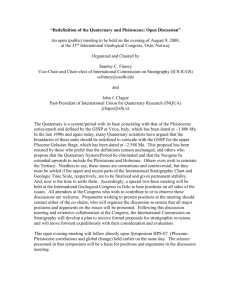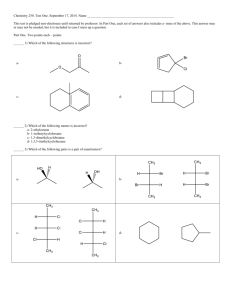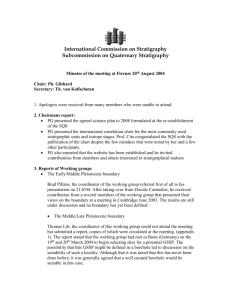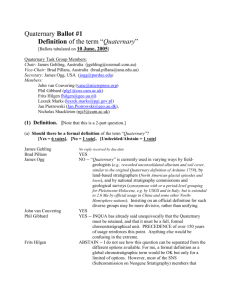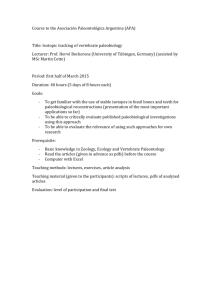Quaternary Reversible/Quantum Logic Synthesis Using Galois Field
advertisement
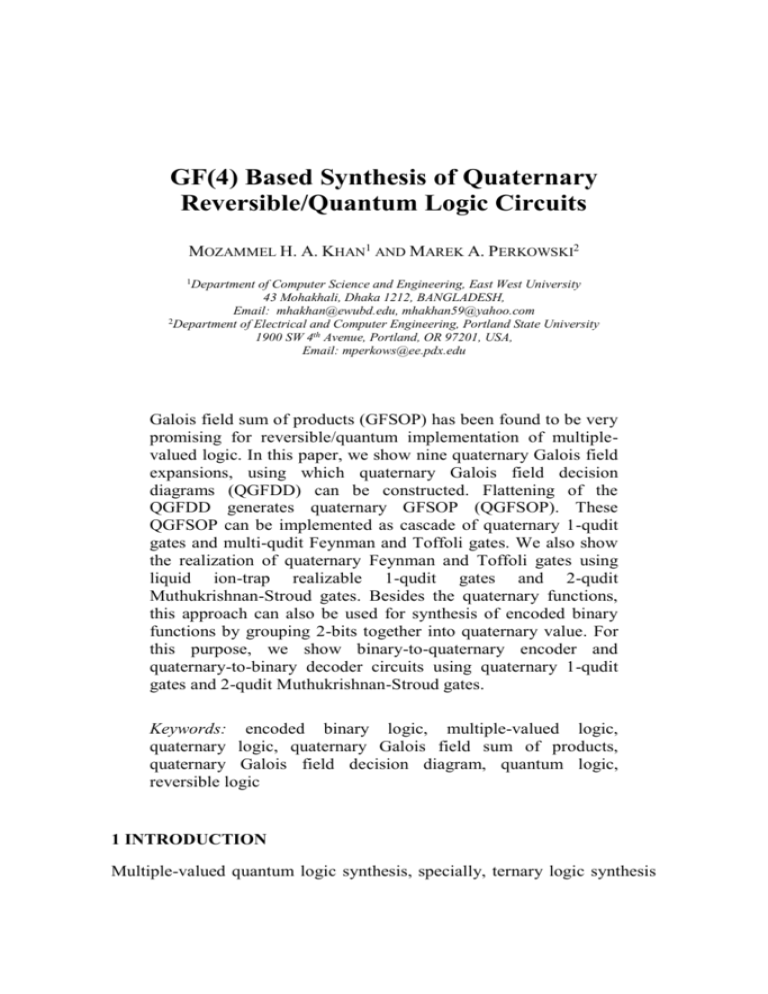
GF(4) Based Synthesis of Quaternary
Reversible/Quantum Logic Circuits
MOZAMMEL H. A. KHAN1 AND MAREK A. PERKOWSKI2
1Department
of Computer Science and Engineering, East West University
43 Mohakhali, Dhaka 1212, BANGLADESH,
Email: mhakhan@ewubd.edu, mhakhan59@yahoo.com
2
Department of Electrical and Computer Engineering, Portland State University
1900 SW 4th Avenue, Portland, OR 97201, USA,
Email: mperkows@ee.pdx.edu
Galois field sum of products (GFSOP) has been found to be very
promising for reversible/quantum implementation of multiplevalued logic. In this paper, we show nine quaternary Galois field
expansions, using which quaternary Galois field decision
diagrams (QGFDD) can be constructed. Flattening of the
QGFDD generates quaternary GFSOP (QGFSOP). These
QGFSOP can be implemented as cascade of quaternary 1-qudit
gates and multi-qudit Feynman and Toffoli gates. We also show
the realization of quaternary Feynman and Toffoli gates using
liquid ion-trap realizable 1-qudit gates and 2-qudit
Muthukrishnan-Stroud gates. Besides the quaternary functions,
this approach can also be used for synthesis of encoded binary
functions by grouping 2-bits together into quaternary value. For
this purpose, we show binary-to-quaternary encoder and
quaternary-to-binary decoder circuits using quaternary 1-qudit
gates and 2-qudit Muthukrishnan-Stroud gates.
Keywords: encoded binary logic, multiple-valued logic,
quaternary logic, quaternary Galois field sum of products,
quaternary Galois field decision diagram, quantum logic,
reversible logic
1 INTRODUCTION
Multiple-valued quantum logic synthesis, specially, ternary logic synthesis
KHAN, et al.
has become popular in the recent years [1-7]. Among them [3, 5, 6] used
cascades of ternary reversible gates like Feynman and Toffoli gates
to realize ternary logic functions. The advantage of this approach is that
ternary logic functions having many input variables can be easily expressed
as ternary Galois field sum of products (TGFSOP) expression and can be
realized using cascade of ternary Feynman and Toffoli gates [3, 5, 6].
Though a considerable number of good works have been done on
reversible/quantum ternary logic synthesis, it has the limitation that
conventional binary logic functions cannot be very easily represented using
the ternary base and the developed methods are applicable only for logic
functions expressed in ternary base. A very promising alternative may be
quaternary logic, using which, besides quaternary logic functions, binary
logic functions can be expressed by grouping 2-bits together into quaternary
values. For a Hilbert space of N dimension, a binary quantum system
requires n2 log 2 N qubits (quantum bits), whereas a quaternary quantum
log 2 N log 2 N
system requires n4 log 4 N
qudits (quantum digits).
log 2 4
2
Therefore, we have
log 2 N
n4
1
2
n2 log 2 N 2
(1)
From (1), we find that 2-bit encoded quaternary realization of binary logic
functions requires 1/2 times qudits than the qubits needed for the binary
realization. Assuming qubit implementation and qudit implementation are
of the same technological complexity, 2-bit encoded quaternary realization
of binary function is efficient than the binary realization. However, for this
purpose, circuits for input encoding and output decoding will be needed and
we show such encoder and decoder circuits in Section 11.
From the experience of ternary logic, it can be expected that quaternary
logic functions having many input variables can also be easily expressed as
quaternary Galois field sum of products (QGFSOP) expression and can be
realized using cascade of quaternary Feynman and Toffoli gates. But the
question arises whether quaternary Feynman and Toffoli gates are
physically realizable or not. Muthukrishnan and Stroud [8] proposed a
family of 2-qudit multiple-valued (d 2) quantum gates, which is
theoretically realizable in liquid ion-trap technology. The macro-level
quaternary Feynman and Toffoli gates can be realized on the top of
Muthukrishnan-Stroud gates as discussed in Sections 8 and 9.
The advantages of quaternary logic and physical realizability of
quaternary Feynman and Toffoli gates require that methods should be
developed for synthesizing quaternary logic functions as a cascade of
QUATERNARY QUANTUM LOGIC SYNTHESIS
quaternary Feynman and Toffoli gates. However, as far as we know, no
work has yet been done on expressing quaternary logic function as
QGFSOP expression and realizing the QGFSOP expression as a cascade of
quaternary Feynman and Toffoli gates. Realization of QGFSOP expression
as a cascade of quaternary Feynman and Toffoli gates is discussed in
Section 10. But the main difficulty arises with expressing quaternary logic
function as QGFSOP expression. The standard technique used in binary and
ternary cases is that a set of expansions is used to construct optimum
decision diagram (DD) and the DD is flattened to determine the minimized
GFSOP expression. In the QGF case the same technique will be useful. But,
as far as we know, no such quaternary Galois field expansion (QGFE) and
algorithm for constructing optimum quaternary Galois field decision
diagram (QGFDD) have yet been reported in the literature.
In this paper, we have developed nine QGFEs using which we can
construct optimum QGFDD. However, constructing optimum QGFDD
requires efficient algorithm for selecting QGFE for each variable and
algorithm for variable ordering. In this paper we concentrated only on
developing QGFEs and showing their usefulness. Development of the above
mentioned algorithms will be the focus of future research. By flattening the
optimum QGFDD we can generate minimized QGFSOP expression. This
QGFSOP expression can be realized as cascade of quaternary 1-qudit gates
and multi-qudit Feynman and Toffoli gates.
2 GALOIS FIELD
A field is a set F with two binary operations - addition (denoted by +) and
multiplication (denoted by or absence of any operator) are defined, which
satisfies the following axioms:
(A1)
(A2)
(A3)
(A4)
(M1)
(M2)
(M3)
(M4)
(D)
a + (b + c) = (a + b) + c (associative law for addition)
a+b=b+a
(commutative law for addition)
There is an element 0 (zero) such that a + 0 = a for all a
For any a, there is an element (a) such that a + (a) = 0
a (b c) = (a b) c
(associative law for multiplication)
ab=ba
(commutative law for multiplication)
There is an element 1 (not equal to 0) such that a 1 = a for all a
For any a 0, there is an element a1 such that a a1 = 1
a (b + c) = (a b) + (a c)
(distributive law)
If p is a prime number, then the integers mod p form a Galois field (also
known as finite field): its elements are the congruence classes of integers
mod p, with addition and multiplication induced from integer mod
operations.
KHAN, et al.
We can construct a Galois filed with q p r elements [abbreviated as
GF(q) or GF( p r )], where p is a prime. The construction of the field is as
follows. First, let F p be the field of integers mod p. Now choose an
irreducible polynomial f(X) of degree r over F p as below:
f ( X ) X r Cr 1 X r 1 C1 X C0
(2)
Now, the elements of F q are all the expressions of the form
x0 x1a x2 a 2 xr 1a r 1
(3)
where a is required to satisfy f(a) = 0, and x 0 , , x r 1 F p . The number of
expressions of the form of (3) is p r , since there are p choices for each of the
r coefficients x 0 , , x r 1 . Adding these expressions is straightforward. To
multiply, we have to consider that
a r Cr 1 a r 1 C1 a C0 0
(4)
For GF(4), q 2 2 , where p = 2 and r = 2. Then (2) reduces to
f ( X ) X 2 C1 X C0
(5)
Equation (5) remains irreducible if we take C1 C 0 1 and the equation
reduces to
f (X ) X 2 X 1
(6)
Also equation (3) reduces to
x 0 x1 a
(7)
where, x 0 , x1 {0,1} . Now, putting different values of x 0 and x1 in (7), we
can find the four elements of F4 as follows:
0 0 a 0
0 1 a a
1 0 a 1
1 1 a 1 a
QUATERNARY QUANTUM LOGIC SYNTHESIS
That means, F4 {0,1, a, a 1} .
The additions of these elements are mod 2 additions as follows:
000
0 1 1
0a a
0 (1 a) 1 a
1 0 1
11 0
1 a 1 a
1 (1 a) a
a0a
a 1 1 a
aa0
a (1 a) 1
(1 a) 0 1 a
(1 a) 1 a
(1 a) a 1
(1 a) (1 a) 0
For GF(4), equation (4) reduces to
a 2 C1 a C0 0
(8)
Taking C1 C 0 1 , equation (8) reduces to
a 2 a 1 0
(9)
From (9), we have using mod 2 addition
a 2 1 a
The multiplications of the elements are as follows:
00 0
0 1 0
0a 0
0 (1 a) 0
1 0 0
11 1
1 a a
(10)
KHAN, et al.
TABLE 1
GF(4) operations.
+
0
1
2
3
0
0
1
2
3
1
1
0
3
2
2
2
3
0
1
3
3
2
1
0
0
1
2
3
0
0
0
0
0
1
0
1
2
3
2
0
2
3
1
3
0
3
1
2
1 (1 a) 1 a
a0 0
a 1 a
a a a2 1 a
a (1 a) a a 2 a 1 a 1
(1 a) 0 0
(1 a) 1 1 a
(1 a) a a a 2 1
(1 a) (1 a) 1 2a a 2 1 2a 1 a a
Now, taking a = 2, F4 {0,1,2,3} and the addition and multiplication
over GF(4) are as shown in Table 1.
GF(4) is also known as quaternary Galois field (QGF).
3 QUATERNARY GALOIS FIELD SUM OF PRODUCTS
EXPRESSION
In quaternary quantum logic system the unit of memory (information) is a
qudit (quantum digit). Logic values of 0, 1, 2, and 3 are represented by a set
of distinguishable different states of an object that represent the qudit.
Quantum gates carry around and manipulate the quantum information. Any
transformation of the qudit state represented by a 4n 4n unitary matrix
specifies a valid n-qudit quantum gate. There are many such non-trivial nqudit gates. In this paper, we consider only the permutation quantum gates,
where the characteristic unitary matrix of the gate has only one 1 in each
row and column and the other elements of the matrix are 0. The advantages
of permutation quantum gates are that they are reversible gates and their
outputs can be described using both truth table and Galois field expression.
There are 4! = 24 possible permutations of 0, 1, 2, and 3. Therefore,
there are 24 possible reversible truth tables and corresponding permutation
unitary matrices for 1-qudit transformations resulting into 24 possible 1qudit permutation/reversible gates. We represent these 1-qudit
QUATERNARY QUANTUM LOGIC SYNTHESIS
TABLE 2
Basic quaternary reversible-literals.
Input
0
1
2
3
Input
0
1
2
3
Input
0
1
2
3
Input
0
1
2
3
Input
0
1
2
3
Input
0
1
2
3
x
0
1
2
3
2x
0
2
3
1
3x
0
3
1
2
x2
0
1
3
2
2x2
0
2
1
3
3x2
0
3
2
1
x+1
1
0
3
2
2x+1
1
3
2
0
3x+1
1
2
0
3
x2+1
1
0
2
3
2x2+1
1
3
0
2
3x2+1
1
2
3
0
x+2
2
3
0
1
2x+2
2
0
1
3
3x+2
2
1
3
0
x2+2
2
3
1
0
2x2+2
2
0
3
1
3x2+2
2
1
0
3
x+3
3
2
1
0
2x+3
3
1
0
2
3x+3
3
0
2
1
x2+3
3
2
0
1
2x2+3
3
1
2
0
3x2+3
3
0
1
2
transformations by 24 basic quaternary reversible-literals as shown in Table
2. As it is very difficult to adopt 24 different symbols for the literals, we
represent a literal by the QGF expression representing the literal. A basic
quaternary reversible-literal multiplied by the constant 2 or 3 produces
another basic quaternary reversible-literal as shown in Tables 3 and 4.
Product of two or more basic quaternary reversible-literals is called a
QGF product (QGFP). For example, (2x+2)(3x2+2)(2x2) is a QGFP. Sum of
two or more QGFP is called a QGFSOP expression. For example,
(2x+2)(3x2+2) + (3x+1)(2x) + x is a QGFSOP expression.
KHAN, et al.
TABLE 3
Product of basic quaternary reversible-literal
and the constant 2.
literal
2(literal)
literal
2(literal)
literal
2(literal)
literal
2(literal)
literal
2(literal)
literal
2(literal)
x
2x
2x
3x
3x
x
x2
2x2
2x2
3x2
3x2
x2
x+1
2x+2
2x+1
3x+2
3x+1
x+2
x2+1
2x2+2
2x2+1
3x2+2
3x2+1
x2+2
x+2
2x+3
2x+2
3x+3
3x+2
x+3
x2+2
2x2+3
2x2+2
3x2+3
3x2+2
x2+3
x+3
2x+1
2x+3
3x+1
3x+3
x+1
x2+3
2x2+1
2x2+3
3x2+1
3x2+3
x2+1
TABLE 4
Product of basic quaternary reversible-literal
and the constant 3.
literal
3(literal)
literal
3(literal)
literal
3(literal)
literal
3(literal)
literal
3(literal)
literal
3(literal)
x
3x
2x
x
3x
2x
x2
3x2
2x2
x2
3x2
2x2
x+1
3x+3
2x+1
x+3
3x+1
2x+3
x2+1
3x2+3
2x2+1
x2+3
3x2+1
2x2+3
x+2
3x+1
2x+2
x+1
3x+2
2x+1
x2+2
3x2+1
2x2+2
x2+1
3x2+2
2x2+1
x+3
3x+2
2x+3
x+2
3x+3
2x+2
x2+3
3x2+2
2x2+3
x2+2
3x2+3
2x2+2
4 QUATERNARY GALOIS FIELD EXPANSIONS
In binary logic, a sum of product expression can be expanded using
Shannon expansion for constructing binary decision diagram. An EXORsum of products expression can be expanded using Shannon, positive
Davio, and negative Davio expansions for constructing Kronecker
functional decision diagram. In a similar line of thinking, we develop
quaternary Galois field expansions (QGFE), so that we can expand a
QGFSOP expression and construct the corresponding quaternary Galois
QUATERNARY QUANTUM LOGIC SYNTHESIS
field decision diagram (QGFDD).
1-reduced Post literal (1-RPL) is defined as follows:
i x 1 if x i
0 otherwise
Quaternary 1-RPLs are shown below:
x x3 1
x x3 x 2 x
2
x x 3 2 x 2 3x
3
x x 3 3x 2 2 x
(11)
The cofactors of a quaternary function
f ( x1 , x2 , , xi , , xn ) with
0
1
(12)
(13)
(14)
respect to the variable xi are defined as follows:
f0
f1
f2
f3
f ( x1 , x2 , ,0, , xn )
f ( x1 , x2 , ,1, , xn )
f ( x1 , x2 , ,2, , xn )
f ( x1 , x2 , ,3, , xn )
We will use sum of two or more cofactors (with or without multiplying by
quaternary constant) and they will be called composite cofactors and
designated as follows:
f 01 f 0 f1
f 02 f 0 f 2
f 03 f 0 f 3
f12 f1 f 2
f13 f1 f 3
f 23 f 2 f 3
f 012 f 0 f1 f 2
f 013 f 0 f1 f 3
f 023 f 0 f 2 f 3
f123 f1 f 2 f 3
f 0123 f 0 f1 f 2 f 3
f1( 22)(33) f1 2 f 2 3 f 3
KHAN, et al.
f1(32)(23) f1 3 f 2 2 f 3
f ( x1 , x2 , , xi , , xn ) can be
expanded with respect to the variable xi using the following expansion:
Theorem 1 Any quaternary function
f ( x1, x2 ,, xi ,, xn )0xi f 0 1xi f1 2xi f 2 3xi f3
(15)
Proof: If xi 0 , then (15) reduces to
f ( x1 ,,0, , xn ) 1 f 0 0 f1 0 f 2 0 f 3 f 0 .
If xi 1 , then (15) reduces to
f ( x1 , ,1, , xn ) 0 f 0 1 f1 0 f 2 0 f 3 f1 .
If xi 2 , then (15) reduces to
f ( x1 , ,2, , xn ) 0 f 0 0 f1 1 f 2 0 f 3 f 2 .
If xi 3 , then (15) reduces to
f ( x1 , ,3, , xn ) 0 f 0 0 f1 0 f 2 1 f 3 f 3 .
Therefore, we have theorem 1.
Theorem 2 Any quaternary function f can be expanded with respect to the
variable x using any of the following nine quaternary Galois field
expansions (QGFE):
QGFE 1:
f f 0 x( x 2)( x 3) f 01 x( x 1)( x 3) f 02 x( x 1)( x 2) f 03
QGFE 2:
f f1 ( x 1)( x 2)( x 3) f 01 x( x 1)( x 3) f12 x( x 1)( x 2) f13
QGFE 3:
f f 2 ( x 1)( x 2)( x 3) f 02 x( x 2)( x 3) f12 x( x 1)( x 2) f 23
QGFE 4:
f f 3 ( x 1)( x 2)( x 3) f 03 x( x 2)( x 3) f13 x( x 1)( x 3) f 23
QUATERNARY QUANTUM LOGIC SYNTHESIS
QGFE 5:
f f 012 x 2 xf03 ( x 2 1)(x 1) f13 ( x 2 3)(x 2) f 23
f 012 2x 2 3xf03 (2x 2 2)(3x 3) f13 (2x 2 1)(3x 1) f 23
f 012 3x 2 2xf03 (3x 2 3)(2x 2) f13 (3x 2 2)(2x 3) f 23
QGFE 6:
f f 013 x 2 xf02 ( x 2 1)(x 1) f12 ( x 2 2)(x 3) f 23
f 013 2x 2 3xf02 (2x 2 2)(3x 3) f12 (2x 2 3)(3x 2) f 23
f 013 3x 2 2xf02 (3x 2 3)(2x 2) f12 (3x 2 1)(2x 1) f 23
QGFE 7:
f f 023 x 2 xf01 ( x 2 3)(x 2) f12 ( x 2 2)(x 3) f13
f 023 2x 2 3xf01 (2x 2 1)(3x 1) f12 (2x 2 3)(3x 2) f13
f 023 3x 2 2xf01 (3x 2 2)(2x 3) f12 (3x 2 1)(2x 1) f13
QGFE 8:
f f123 ( x 2 1)(x 1) f 01 ( x 2 3)(x 2) f 02 ( x 2 2)(x 3) f 03
f123 (2x 2 2)(3x 3) f 01 (2x 2 1)(3x 1) f 02 (2x 2 3)(3x 2) f 03
f123 (3x 2 3)(2x 2) f 01 (3x 2 2)(2x 3) f 02 (3x 2 1)(2x 1) f 03
QGFE 9:
f f 0 x 2 xf 0123 x 2 f1( 22)(33) xf1(32)(23)
Proof: From the expansion of (15) and the definition of quaternary 1-RPL
of (11 ) to ( 14), we have
f ( x3 1) f 0 ( x3 x 2 x) f1 ( x3 2x 2 3x) f 2 ( x3 3x 2 2x) f3
f 0 x3 f 0 ( x3 x 2 x) f1 ( x3 2x 2 3x) f 2 ( x3 3x 2 2x) f3
f 0 [( x 3 x 2 x) ( x 3 2 x 2 3x) ( x 3 3x 2 2 x)] f 0
( x 3 x 2 x) f1 ( x 3 2 x 2 3x) f 2 ( x 3 3x 2 2 x) f 3
f 0 ( x 3 x 2 x)( f 0 f1 ) ( x 3 2 x 2 3x)( f 0 f 2 )
( x 3 3x 2 2 x)( f 0 f 3 )
f 0 ( x3 x 2 x) f 01 ( x3 2x 2 3x) f 02 ( x3 3x 2 2x) f 03
f 0 x( x 2)( x 3) f 01 x( x 1)( x 3) f 02 x( x 1)( x 2) f 03
KHAN, et al.
TABLE 5
An example quaternary function.
xy
00
01
02
03
10
11
12
13
20
21
22
23
30
31
32
33
f
0
1
2
3
1
0
3
2
2
3
0
1
3
2
1
0
Thus we prove QGFE 1. Similarly, we can prove QGFE 2 to 9. Thus we
have theorem 2.
5 QUATERNARY GALOIS FIELD DECISION DIAGRAM
Using the QGFE 1 - 9, we can construct quaternary Galois field decision
diagram (QGFDD) of any quaternary logic function. Using different choices
of expansions for a variable and using different variable ordering, we can
construct many Kronecker like QGFDD. By flattening these decision
diagrams, we can generate several QGFSOP expressions. A decision
diagram with minimum number of paths to non-zero leaves will produce a
minimum QGFSOP expression. A minimum QGFSOP expression will
result into a minimum quantum circuit realizing the function.
A 2-input 1-output quaternary function [GF(4) sum of x and y] is shown
in Table 5. Applying QGFE 1 to variable x and QGFE 2 to variable y, we
get the QGFDD for the function of Table 5 as shown in Figure 1.
Observation of the QGFE 1 - 9 reveals that a QGFE is a QGFSOP of four
products and each of the products is a product of one composite cofactor
and one or more quaternary reversible literals. Therefore, each node of the
QGFDD has four children and they are arranged from left to right in the
same order as in the corresponding QGFE. In the QGFDD, we write only
the subscripts of the corresponding composite cofactors along the edges and
QUATERNARY QUANTUM LOGIC SYNTHESIS
f
x
QGFE 1
03
0
01 02
QGFE2
QGFE2
12 01 / 12 / 13
1
1 / 01
13
0
QGFE2
QGFE2
01 / 12 / 13
01 / 12 / 13
1
1
y
1
3
2
FIGURE 1
QGFDD for the function of Table 5 using QGFE1
and 2.
f
QGFE9
0
0123
QGFE9
1( 2 2)(3 3) /
1(3 2)( 2 3)
1(3 2)( 2 3)
1( 2 2)(3 3)
0
1( 2 2)(3 3)
0123 /
QGFE9
0 / 0123 /
x
1(3 2)( 2 3)
1
2
y
0
3
FIGURE 2
QGFDD for the function of Table 5 using QGFE9.
the corresponding product of reversible literals are implied. For example,
we applied QGFE 1 to variable x. QGFE 1 has four parts having composite
cofactors f 0 , f 01 , f 02 , and f 03 and they are written in the QGFDD of
Figure 1 along the edges of the four children of the top node. If more than
one child goes to the same node, then the corresponding composite
cofactors are written along the single edge separated by slash (/). If we
apply QGFE 9 on both the variables x and y, then we get the QGFDD as
shown in Figure 2. Construction of QGFDD is not within the scope of this
paper and, therefore, is not discussed.
KHAN, et al.
x
QGF exp
FIGURE 3
Representation
quaternary reversible
qudit gates.
y
of
1-
The QGFDD is flattened to write the QGFSOP expression
corresponding to the QGFDD. For flattening the QGFDD, we write the
products of the reversible literals of the edges and the leaf constant along all
paths. For example, flattening of the left most path of the QGFDD of Figure
1 yields 1 1 1 1 ( y 1)( y 2)( y 3) 1 1 ( y 1)( y 2)( y 3) . As
product of zero and anything is zero, we need not to flatten the paths
terminated at zero-leaf. By flattening the QGFDD of Figure 1, we have the
following QGFSOP expression:
f 1 ( y 1)( y 2)( y 3) 3 y ( y 1)( y 3)
2 y ( y 1)( y 2) x( x 2)( x 3)
(16)
2 x( x 1)( x 3) 3x( x 1)( x 2)
Similarly, by flattening the QGFDD of Figure 2, we have the following
QGFSOP expression:
f x y
(17)
These examples show that efficient algorithms are needed to select
expansion for each variable and to construct the QGFDD so that the
QGFDD and the resulting QGFSOP expression are minimum. In this work,
we concentrated only on developing the expansions, not on the development
of the said algorithms, which will obviously be our next attention.
6 QUATERNARY 1-QUDIT REVERSIBLE/QUANTUM GATES
Each of the 24 quaternary reversible-literals can be implemented as 1-qudit
gates using quantum technology [8] and other reversible technologies. We
will graphically represent these 1-qudit gates as shown in Figure 3.
QUATERNARY QUANTUM LOGIC SYNTHESIS
PA
A
B
z - transform of B if A 3
Q
otherwise
B
z is any 1 - qudit tran sform of Table 2
z
FIGURE 4
Quaternary Muthukrishnan-Stroud gate family.
A
PA
B
Q A B (GF4)
FIGURE 5
Quaternary Feynman gate.
7 QUATERNARY 2-QUDIT MUTHUKRISHNAN-STROUD GATE
FAMILY
Muthukrishnan and Stroud [8] proposed a family of 2-qudit multiple-valued
gates that are realizable (theoretically shown but not tested in the lab) in
liquid ion-trap quantum technology. The quaternary form of the gate family
is shown in Figure 4. We will refer this family of gates as quaternary
Muthukrishnan-Stroud (M-S) gates. M-S gate is basically a controlled 2qudit gate that applies a 1-qudit transform on the controlled input B when
the controlling input A is 3.
8 QUATERNARY FEYNMAN GATE
Quaternary Feynman gate is shown in Figure 5, where A, B are inputs, P =
A is the pass through output and Q A B (GF4) is the controlled output.
Quaternary Feynman gate is a macro-level gate and can be realized using
M-S primitive gate as shown in Figure 6. In Figure 6,
P (( A 2) 3) 1 A . If A 0 , then a1 2 , a2 1 , a3 0 and none of
the transform will be applied to B and the output will be
Q B B 0 A B . If A 1 , then a1 3 , a2 0 , a3 1 and only the
left transform (B+1) will be applied to B and the output will be
Q B 1 A B . If A 2 , then a1 0 , a2 3 , a3 2 and the middle
transform (B+2) will be applied on B and the output will be
Q B 2 A B . If A 3 , then a1 1 , a2 2 , a3 3 and the right
KHAN, et al.
A
B
2
a1
1
3
a2
2
1
a3
PA
3
Q A B [GF(4)]
FIGURE 6
Realization of quaternary Feynman gate. [+1 x
+ 1, +2 x + 2, +3 x + 3, where x is the
corresponding input]
A
PA
B
QB
C
R AB C [GF(4)]
FIGURE 7
Quaternary Toffoli gate.
transform (B+3) will be applied on B and the output will be
Q B 3 A B . Therefore, for all values of A, P = A and Q = A + B
[GF(4)].
9 QUATERNARY TOFFOLI GATE
Quaternary Toffoli gate is shown in Figure 7, where A and B are controlling
inputs and C is the controlled input. P = A and Q = B are the pass through
outputs and R AB C [GF(4)] is the controlled output. Quaternary
Toffoli gate is a macro-level gate and can be realized using M-S primitive
gates as shown in Figure 8.
In Figure 8, the resultant transformation along the input line B is
(( B 2) 3) 1 B , i.e., Q B . Now, we will check the correctness of P
= A. If B 0 , then b1 2 , b2 1 , b3 0 and no controlled-transformation
along the input line A will be applied. In this case, only the uncontrolledtransformations will be applied along the input line A and a1 A ,
a2 2a1 2 A , a3 2a2 2 2 A 3 A , and P 2a3 2 3 A A . If B = 1,
then b1 3 , b2 0 , b3 1 and only the controlled-transformations of
segment-1 along the input line A will be applied. In this case,
a1 (( A 2) 3) 1 A , a2 2a1 2 A , a3 2a2 2 2 A 3 A , and
P 2a3 2 3 A A . If B = 2, then b1 0 , b2 3 , b3 2 and only the
QUATERNARY QUANTUM LOGIC SYNTHESIS
B
0
3
2
A
1
a1
2
b1
2
1
2
3
3
2
1
3
t1
a2
b2
1
2
3
2
3
2
1
1
t2
a3
2
PA
b3
QB
t 3 AB
1
2
3
3
2
1
AB
3
2
Segment 4 R AB C [GF(4)]
1
C
Segment 1
Segment 2
Segment 3
FIGURE 8
Realization of quaternary Toffoli gate. [+1 x + 1, +2 x + 2, +3 x
+ 3, 2 2x, where x is the corresponding input]
controlled-transformations of segment-2 will be applied along the input line
A.
In
this
case,
a1 A ,
a2 (( 2a1 2) 3) 1 2a1 2 A ,
a3 2a2 2 2 A 3 A , and P 2a3 2 3 A A . If B = 3, then b1 1 ,
b2 2 , b3 3 and only the controlled-transformations of segment-3 will be
applied along the input line A. In this case, a1 A , a2 2a1 2 A ,
and
a3 (( 2a2 2) 3) 1 2a2 2 2 A 3 A ,
P 2a3 2 3 A A .
Therefore, for all values of the controlling input B, P = A. Now we will
verify the correctness of t3 AB . If B 0 , then as discussed earlier,
a1 A , a2 2 A , a3 3 A . If A = 0, then a1 a2 a3 0 and no
controlled-transformation will be applied along the constant input line 0. So,
t1 t2 t3 0 0 0 AB . If A = 1, then a1 1 , a2 2 , a3 3 and only
the controlled-transformations of segment-3 will be applied along the
constant input line 0. So, t1 t2 0 , t3 ((0 1) 2) 3 0 1 0 AB . If
A 2 , then a1 2 , a2 3 , a3 1 and only the controlled-transformations
of segment-2 will be applied along the constant input line 0. So, t1 0 ,
t2 ((0 1) 2) 3 0 , t3 t2 0 2 0 AB . If A 3 , then a1 3 ,
a2 1 , a3 2 and only the controlled-transformations of segment-1 will be
applied along the constant input line 0. So, t1 ((0 1) 2) 3 0 ,
t2 t3 t1 0 3 0 AB . Therefore, for B = 0 and all possible values of
A, t3 AB . In a similar fashion, it can be shown that for all possible values
of A and B, t3 AB . Segment-4 of Figure 8 is a quaternary Feynman gate
and the output R = AB + C [GF(4)]. A mirror circuit can be used at the right
of segment-4 to restore the constant 0 for further use in the cascaded
application of the gate.
Toffoli gates with more than three inputs are often used. A four-input
Toffoli gate and its realization using three-input Toffoli gates are shown in
Figure 9. The first three-input Toffoli gate with input 0 is used to generate
KHAN, et al.
A
A
A
B
B
B
C
C
ABC D
0
D
(a) Symbol
A
B
AB
C
0
C
ABC D
D
(b) Realizatio n
FIGURE 9
Four-input quaternary Toffoli gate.
AB. The second three-input Toffoli gate is used to generate
( AB) C D (GF4) . The third Toffoli gate is used as a mirror gate to
restore the constant 0 for reusing in the next stage of the cascade. Using
similar technique, Toffoli gate with any number of inputs can be realized.
10 SYNTHESIS OF QGFSOP EXPRESSION
The synthesis of a QGFSOP expression can be done as follows:
1.
2.
3.
4.
Realize a literal of a variable by using a quaternary 1-qudit gate.
If multiple literals of a variable is simultaneously needed, generate
copies of the variable using quaternary Feynman gates by connecting
the variable to the controlling input and putting a 0 to the controlled
input [0 + x (GF4) = x]. Then realize the literals along the copies.
Realize a QGF product using a quaternary Toffoli gate by connecting
the literals of the product to the controlling inputs and a 0 to the
controlled input [0 + xyz (GF4) = xyz].
Realize a sum of two products by connecting the controlled output of
the first Toffoli gate (implementing the first QGF product) to the
controlled input of the second Toffoli gate (implementing the second
QGF product).
Realization of the QGFSOP expression of (16) is shown in Figure 10.
The QGFSOP expression (17) can be implemented with a single Feynman
gate.
11 BINARY-TO-QUATERNARY ENCODER AND QUATERNARYTO-BINARY DECODER CIRCUITS
The developed QGFSOP method can be effectively used for synthesis of
binary function by grouping 2-bit together into quaternary value. For this
QUATERNARY QUANTUM LOGIC SYNTHESIS
x
0
0
0
0
0
y
0
0
0
0
0
x
x 1
x
x2
x
x3
x
x
2x
3x
y
y 1
y
y2
y
y3
y
y
2y
3y
1
f
FIGURE 10
Realization of QGFSOP expression.
purpose we need binary-to-quaternary encoder and quaternary-to-binary
decoder circuits.
A binary-to-quaternary encoder circuit using quaternary 1-qudit gates
and 2-qudit M-S gates is shown in Figure 11. It is assumed that among the
four quaternary qudit states only 0 and 1 will used for inputs A1 A0 . If
A1 A0 00 , then A1* A0* 22 and no transformation will be applied on B,
therefore, B 0 . If A1 A0 01 , then A1* A0* 23 and only +1 transformation
will be applied on B, therefore, B 1 . If A1 A0 10 , then A1* A0* 32 and
only +2 transformation will be applied on B, therefore, B 2 . If A1 A0 11 ,
then A1* A0* 33 and both +1 and +2 transformations will be applied on B,
therefore, B 3 .
KHAN, et al.
A0
2
A0*
2
A1
1
0
A1*
2
B
FIGURE 11
Binary-to-quaternary encoder
circuit using quaternary 1-qudit
gates and 2-qudit M-S gates.
B
0
1
B
0
2
1
0
1
B0
B1
1
A0
1
A1
FIGURE 12
Quaternary-to-binary decoder circuit using
quaternary Feynman gate, 1-qudit gates and 2qudit M-S gates.
A quaternary-to-binary decoder circuit using quaternary Feynman gate,
1-qudit gates, and 2-qudit M-S gates is shown in Figure 12. If B 0 , then
B1 B0 21 and no transformation will be applied along A1 and A0 ,
therefore, A1 A0 00 . If B 1 , then B1 B0 32 and only +1 transformation
will be applied along A0 and no transformation will be applied along A1 ,
therefore, A1 A0 01 . If B 2 , then B1 B0 03 and only +1 transformation
will be applied along A1 and no transformation will be applied along A0 ,
therefore, A1 A0 10 . If B 3 , then B1 B0 12 and +1 transformation will
be applied along both A1 and A0 , therefore, A1 A0 11 .
12 CONCLUSION
Multiple-valued logic functions having many input variables can be easily
expressed as Galois field sum of products (GFSOP) expression and can be
realized using cascade of multiple-valued 1-qudit gates and multi-qudit
Feynman and Toffoli gates [3, 5, 6]. Though a considerable number of
useful works have been done on ternary logic synthesis, as far as we know,
QUATERNARY QUANTUM LOGIC SYNTHESIS
no work has yet been done on expressing quaternary function as quaternary
Galois field sum of products (QGFSOP) expression and realizing the
QGFSOP expression as a cascade of quaternary gates. In this paper, we
have developed nine quaternary Galois field expansions (QGFE). These
expansions can be used for constructing quaternary Galois field decision
diagrams (QGFDD) of any quaternary function. By flattening the QGFDD
we can generate quaternary Galois field sum of products (QGFSOP)
expression for the function. However, in this work, we did not explore the
algorithms for selecting expansion for a variable and to construct the
QGFDD so that the resulting QGFDD and the QGFSOP expression are
minimum. We have also shown example of implementation of QGFSOP
expression as a cascade of quaternary 1-qudit gate, Feynman gate, and
Toffoli gate.
For QGFSOP based quantum realization of functions with many input
variables, we need to use quantum gates with many inputs. However,
quantum gate with more than two inputs is very difficult to realize as a
primitive gate, since interaction of more than two particles is nearly
impossible to manage. In this paper, we have shown the quantum realization
of macro-level quaternary 2-qudit Feynman and 3-qudit Toffoli gates on the
top of theoretically liquid ion-trap realizable 1-qudit gates and 2-qudit
Muthukrishnan-Stroud primitive gates [8]. We also show the realization of
m-qudit (m > 3) Toffoli gates using 3-qudit Toffoli gates.
The quaternary base is very useful for encoded realization of
conventional binary function by grouping two bits together into quaternary
values. We show quantum circuit for binary-to-quaternary encoder and
quaternary-to-binary decoder for this purpose.
The presented method is especially applicable to quantum oracles where
only one function output is of importance and input qudits are copied to
output. Such circuits are of particular importance in Grover algorithm or
similar quantum algorithms. Our method can be adapted to multi-output
reversible functions with paying the price of having one ancilla qudit for
every output function. Observe that this method, in contrast to most
methods from literature, also performs a conversion of a non-reversible
function to a reversible one as a byproduct of the synthesis process.
Comparing to the methods from literature, our method can be used for large
functions. As it is using Galois logic, the circuits are highly testable [9]. In
contrast, other papers on multiple-valued quantum logic cascade synthesis
[1, 7] use the directly controlled multi-input gates based on MuthukrishnanStroud gates rather than the Galois-based Toffoli gates proposed here. How
to build an optimal multi-input Toffoli gate using minimum number of
quantum multiplexers or technology-realizable M-S gates remains an open
problem. Some studies were done in [10]. It will be interesting to compare
the methods from [1, 7] adapted to quaternary logic and the method
KHAN, et al.
proposed in this paper in terms of costs of truly quantum-realizable pulses
or other low-level primitives as those discussed in [10].
Our future research includes (1) developing more QGFEs, if such
expansions exist and (2) developing algorithms for (i) selecting expansion
for each variable, (ii) variable ordering, and (iii) constructing QGFDD
(Kronecker and pseudo-Kronecker types) for both single-output and multioutput functions so that the resulting QGFDD and the corresponding
QGFSOP expression are minimized.
REFERENCES
[1] Curtis, E., Perkowski, M. (2004). A transformation based algorithm for ternary
reversible logic synthesis using universally controlled ternary gates. Proc.
IWLS 2004, Tamecula, California, USA, 2-4 June 2004.
[2] Denler, N., Yen, B., Perkowski, M., Kerntopf, P. (2004). Synthesis of
reversible circuits from a subset of Muthukrishnan-Stroud quantum multivalued gates. Proc. IWLS 2004, Tamecula, California, USA, 2-4 June 2004.
[3] Khan, M. H. A., Perkowski, M. A., Khan, M. R., Kerntopf, P. (2005). Ternary
GFSOP minimization using Kronecker decision diagrams and their synthesis
with quantum cascades. Journal of Multiple-Valued Logic and Soft Computing,
11, 2005, pp. 567-602.
[4] Khan, M. H. A., Perkowski, M. A. (2004). Genetic algorithm based synthesis
of multi-output ternary functions using quantum cascade of generalized ternary
gates. Proc. of 2004 IEEE Congress on Evolutionary Computation (CEC
2004), Portland, Oregon, USA, 19-23 June 2004, pp. 2194-2201.
[5] Khan, M. H. A., Perkowski, M. A., Khan, M. R. (2004). Ternary Galois field
expansions for reversible logic and Kronecker decision diagrams for ternary
GFSOP minimization. Proc. of 34th IEEE Int. Symp. on Multiple-Valued Logic
(ISMVL 2004), Toronto, Canada, 19-22 May 2004, pp. 58-67.
[6] Khan, M. H. A., Perkowski, M. A., Kerntopf, P. (2003). Multi-output Galois
field sum of products synthesis with new quantum cascades. Proc. 33rd IEEE
Int. Symp. On Multiple-Valued Logic (ISMVL 2003), Tokyo, Japan, 16-19 May
2003, pp. 146-153.
[7] Miller, D. M., Dueck, G., Maslov, D. (2004). A synthesis method for MVL
reversible logic. Proc. 34th IEEE Int. Symp. On Multiple-Valued Logic (ISMVL
2004), Toronto, Canada, 19-22 May 2004, pp. 74-80.
[8] Muthukrishnan, A., Stroud Jr., C. R. (2000). Multivalued logic gates for
quantum computation. Physical Review A, 62, 052309/1-8.
[9] Kalay, U., Hall, D., Perkowski, M. (1998). A minimal and universal test set for
multiple-valued Galois field sum-of-products circuits. Proc. 7th Workshop on
Post-Binary ULSI Systems, Fukuoka, Japan, May 1998, pp. 50-51.
[10] Giesecke, N., Kim, D. H., Hossain, S., Perkowski, M. (2007). Search for
universal ternary quantum gate sets with exact minimum costs. 37th IEEE Int.
Symp. On Multiple-Valued Logic (ISMVL 2007), Oslo, Norway, 14-15 May
2007.
